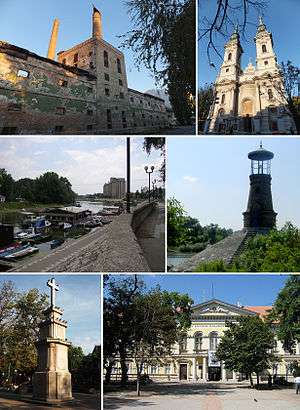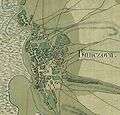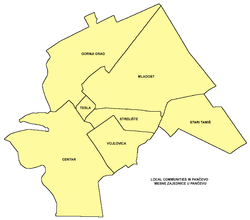Pančevo
| Pančevo Панчево | |||
|---|---|---|---|
| City | |||
 | |||
| |||
 Pančevo Location of Pančevo within Serbia | |||
 Pančevo Location of Pančevo within Vojvodina | |||
| Coordinates: 44°52′14″N 20°38′25″E / 44.87056°N 20.64028°ECoordinates: 44°52′14″N 20°38′25″E / 44.87056°N 20.64028°E | |||
| Country | Serbia | ||
| Province | Vojvodina | ||
| District | South Banat | ||
| Government | |||
| • Mayor | Saša Pavlov (SNS) | ||
| Elevation | 80 m (260 ft) | ||
| Population (2011) | |||
| • City | 76,203 | ||
| • Density | 512/km2 (1,330/sq mi) | ||
| • Metro | 123,414 | ||
| Time zone | CET (UTC+1) | ||
| • Summer (DST) | CEST (UTC+2) | ||
| Postal code | 26000 | ||
| Area code(s) | +381(0)13 | ||
| Car plates | PA | ||
| Website | www.pancevo.rs | ||

Pančevo (Serbian Cyrillic: Панчево, pronounced [pâːnt͡ʃe̞v̞ɔ̝], Hungarian: Pancsova, Romanian: Panciova, Slovak: Pánčevo) is a city located in the southern part of Autonomous Province of Vojvodina, in Republic of Serbia. Pančevo is located on the banks of the Danube and Tamiš, in the southern part of Banat, and it's the administrative headquarters of the city of Pančevo and the South Banat District.
Pančevo is the fourth largest city in Vojvodina by population. According to preliminary results of the 2011 census, 76,203 people live in Pančevo. According to the official results of the year 2011, the city of Pančevo has 123,414 inhabitants.
Name
In Serbian, the town is known as Pančevo (Панчево), in Hungarian as Pancsova, in Turkish as Pançova, in German as Pantschowa, in Romanian as Panciova, in Slovak as Pánčevo, in Rusyn as Панчево (Pančevo).
History
Early history
8th century BC bird-shaped fibulae were found in the town.[1]
The first historical record mentioning the town is from 1153 book of "Idrisia" when it was a mercantile harbour. The city was populated by Serbs and was administered by the Bulgarian Empire in the 9th and 11th century and later by the Kingdom of Hungary, until the 16th century, when it became part of the Ottoman Empire. During the Ottoman rule, the city was part of the Ottoman Province of Temeşvar and was a large settlement mostly populated by ethnic Serbs.
Habsburg Monarchy
After 1716, the city was under Habsburg rule, and was included into Habsburg military province named Banat of Temeswar. In 1751, the northern parts of the province were placed under civil administration, while the southern parts (including Pančevo) were included into Military Frontier (Banat Krajina). During this time the Habsburg administration encouraged massive immigration of German settlers to develop the land. Soon the town of Pančevo was divided into two municipalities: one Serb, one "German". According to the 1767 data, the population of the Serb municipality numbered 424 families, while the population of the German municipality numbered 132 families. According to the 1787 data, the population of the city was composed of 3,506 Orthodox Christians and 2,005 Roman Catholics. The city was briefly restored to Ottoman administration from 1787 to 1788. In 1794, Serb and German municipality were joined into one.
-

Map of Pančevo (BANCZOVA) in 1769-1792
-

Austrian stamp of Pančevo (PANCSOVA) in 1859
In 1848/1849, Pančevo was part of the Serbian Voivodship, a Serb autonomous region within Austrian Empire, but in 1849 it was returned under administration of the Military Frontier. In 1873, the Banatian Military Frontier was abolished and the city was included into Torontal county. According to the 1910 census, the population of the city was 20,808, of whom 8,714 spoke Serbian language, 7,467, German language, 3,364 Hungarian language, etc.
After 1918
In 1918, Pančevo (with the rest of western Banat) became part of the Kingdom of Serbs, Croats and Slovenes (later renamed to Yugoslavia). According to the 1921 data, the population of the city was 19,362, of whom 9,422 were Serbs, 7,237 Germans, 887 Hungarians, etc. Between 1918 and 1922, the city was part of the Banat county, between 1922 and 1929 it was part of the Belgrade oblast, and between 1929 and 1941 it was part of the Belgrade city administration.
In April 1941, Pančevo was occupied as part of the invasion of Yugoslavia by Nazi Germany. Soldiers of the Infantry Regiment Grossdeutschland committed a war crime in the town cemetery when 35 men and one woman were executed as a reprisal for the deaths of four German soldiers. Propaganda photos and film of the executions were used decades after the event to help chronicle the Wehrmacht's complicity in German atrocities during the war.[2]
Between 1941 and 1944, Pančevo was under Axis occupation and was part of the autonomous Banat within German-occupied Serbia. Many local Danube Swabians were enlisted in the Waffen-SS after failing to volunteer in sufficient numbers. During the war, between 1941 and 1944, fascists killed about 12,000 people at the Small Marsh locality near Pančevo, including 6-7,000 Jews from Vojvodina, Serbia and Hungary.[3] Following the war, most Danube Swabians left from the city, together with occupational German army. Minority of them who remained in the city were expropriated of their private property and expelled; some men were murdered.
During 1999 the city was heavily bombed by NATO forces. Targets included an oil refinery, the Utva aircraft factory and chemical plants.
Inhabited places
The Pančevo municipality includes the city of Pančevo and the following villages:
City quarters

LC Gornji grad:
- Bela Stena
- Gornji grad
- Karaula
- Skrobara
LC Kotež:
- Kotež 1
- Kotež 2
LC Mladost:
- Kudeljarski nasip
- Misa
- Mladost
LC Stari Tamiš:
- Stari Tamiš
LC Strelište:
- Strelište
LC Tesla:
- Tesla
LC Centar:
- Donji grad
- Zelengora
- Mali London
- Pepeljara
- Sodara
- Topola
- Utvina kolonija
- Centar
Demographics
According to official results from the 2011 Census, Pančevo has a population of 123,414. According to the 2011 census, nationality in the municipality of Pančevo are: Serbs (97,499), Macedonians (4,558), Romanians (3,173), Hungarians (3,422), Roma (2,118), and Slovaks (1,411).
Culture
Pančevo has one of the oldest monasteries in this region. Currently it is situated inside of Oil refinery (See Vojlovica monastery article).
City has many cultural events. One of them is ArtTech, international festival of digital arts.
Economy
Pančevo has a strong industrial background with the petrochemical, fertilizer, machinery, and aircraft industries (See: Lola Utva aircraft factory, at the local airfield). It has a single oil refinery.
Gallery
-

Main municipal building
-

Pančevo National Museum, formerly the city's historical municipal building
-

Gymnasium "Uroš Predić" in Pančevo
-

Gymnasium "Uroš Predić" in Pančevo
-

Old hospital building
-

Municipal court in Pančevo
-

Roman Catholic church in Pančevo
-

Suburban railway station, between Kotež 2 and Misa
-

Suburban railway station
-

The Old Town
-

Central bus station
-

Main postal building
-

Old Uptown Church
-

Serbian orthodox church
-

Public library building
Twin cities
Famous citizens
- Milos Crnjanski, writer
- Uroš Predić, artist
- Mihailo Pupin, scientist
- Anđelko Đuričić, football player
- Dejan Perić, former handball player
- Đorđe Vajfert, industrialist of German descent, Governor of the National Bank of Serbia and later Yugoslavia
- Marina Munćan, athlete
- Nađa Higl, swimmer, World Champion in 200m Breststroke
See also
| Wikimedia Commons has media related to Pančevo. |
References
- ↑ http://sehumed.uv.es/revista/numero16/SEHUMED_colecc131.PDF
- ↑ Jürgen Martschukat, Violence and Visibility in Modern History, p.182 accessed online at http://books.google.ca/books?id=4zewAgAAQBAJ&pg=PA182&lpg=PA182&dq=pancevo+wehrmacht+der+spiegel&source=bl&ots=99vgXKg-Jq&sig=Is67Qtd_AuJ0EpUAHdmzUCO-hl4&hl=en&sa=X&ei=UxgbU4LzB4zioATmnoHwAg&ved=0CEkQ6AEwAw#v=onepage&q=pancevo%20wehrmacht%20der%20spiegel&f=false
- ↑ Soviet Jewish affairs, Volumes 11-12, Institute of Jewish Affairs, World Jewish Congress, 1981.
External links
- The local radio television station
- Official local government site
- South Banat district portal K-013 with all informations from Pancevo and region.(serbian,english...)
- Pančevo web portal - Provides all city information's
- Pancevo on the internet
- The unofficial pancevo site
- The local newspaper "Pančevac"
| ||||||||||||||||||||||||||||||||||||||




